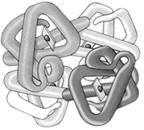Which of the following is not a property of carbon?
Carbon-to-carbon bonds are limited to single bonds.

The number of electron pairs shared between carbon 2 and 3 in the accompanying figure is:
two.

The two molecules in the following figure represent
Geometric isomers.
The highly polarized nature of compounds containing carboxyl groups can be attributed to the presence of two:
Highly electronegative oxygen atoms.
This functional group is weakly basic because it can accept an H+ ion:
amino.
Hydrocarbons are hydrophobic because:
The covalent bonds between hydrogen and carbon are nonpolar.
The chemical interactions of large organic molecules are largely determined by:
their functional groups.
Which of these terms is most inclusive?
carbohydrate.
Carbohydrate molecules:
are a source of energy.
A chemical reaction in which monomers become covalently linked and thus synthesizes polymers from their building blocks is called:
Condensation.

Figure 3-1 Use the figure below to answer the corresponding question(s). The process illustrated in Figure 3-1 is called:
Hydrolysis.
In which of the following reactions must the equivalent of a water molecule be added in order to break a bond?
glycogen → glucose
Which of the following illustrates hydrolysis?
the reaction of a fat to form glycerol and fatty acids.
Glucose dissolves in water because:
it has polar hydroxyl groups that interact with polar water molecules.
The difference between a hexose and a pentose is that:
a hexose always has six carbons, but a pentose always has five carbons.
Monosaccharides are water soluble because:
they have a large number of polar hydroxyl groups.
Which pair is mismatched?
monsaccharide - maltose.
Which one of the following carbohydrates is the most structurally complex?
Cellulose.
Amyloplasts are organelles that store:
Starch.
A carbohydrate energy storage molecule found in animal liver and muscle cells is:
Glycogen.
Which of the following is NOT true of lipids?
They have many oxygen-containing functional groups.
The hydrolysis of triacylglycerol will yield:
Three fatty acids and one glycerol.
Which of the following molecules is NOT grouped with the lipids.
Glycoproteins.
A molecule of a saturated triacylglycerol contains:
The maximum number of hydrogen atoms in the fatty acid chains.
Which of the following statements concerning unsaturated fats is correct?
They are generally liquid at room temperature.
An amphipathic molecule has:
A hydrophobic and a hydrophilic portion.
If you partially hydrogenate oleic acid, the resulting molecule most likely would:
have a double bond changed from cis to trans .
You isolate a compound that is insoluble in water, has alternating single and double bonds, and has a bright orange color. You correctly conclude that this compound is a:
carotenoid.
Which of the following statements concerning steroids is FALSE?
They are always detrimental to living organisms.

The most abundant molecules in this structure are:
Phospholipids.
The primary difference between the amino acids commonly found in proteins is in their:
R or variable groups.
Amino acids are important biological buffers because:
their amino and carboxyl groups can accept and release protons (H+ ).

The following amino acid would be characterized as __ based on the chemical properties of its side chain.
Nonpolar.
Which of the following is responsible for the alpha-helical structure of proteins?
Hydrogen bonds.
Proteins with alpha-helical forms exhibit this property:
Elasticity.
If glycine and alanine undergo condensation, the new bond that is formed is between the:
carbon of the carboxyl group and the nitrogen of the amino group.

Figure 3-2 Use the figure below to answer the corresponding question(s). In Figure 3-2, ionic bonds would form between the R groups of which amino acids?
2 and 4.

All of the following types of chemical bonds are responsible for maintaining the tertiary structure of this polypeptide except:
Peptide bond.
Molecular chaperones are proteins that mediate the folding process of:
Other proteins.

If the differently shaded portions of this molecule represent different polypeptide chains, then this figure is representative of:
the quaternary structure of a protein.
Which of the following statements is true of proteins?
Proteins lose some or all of their normal activity if their three-dimensional structure is disrupted.
This molecule transmits heredity information:
Nucleic acid.
DNA most directly determines which __ are made by a cell.
Proteins.
Which of the following statements best summarizes the differences between RNA and DNA?
DNA comprises the genes, while RNA is a direct participant in the process of protein synthesis.

Figure 3-3 Use the figure to answer the corresponding question(s). The molecular fragment represented in Figure 3-3 is:
RNA.

Figure 3-3 Use the figure to answer the corresponding question(s). The type of connection between the atoms at the point labeled 1 in Figure 3-3 is:
a phosphodiester linkage.
Analysis of a certain polymer shows that it contains phosphate groups, ribose sugars, and pyrimidines. Based on this information, which of the following is the best description of this compound?
It is most likely ribonucleic acid.
Which pair matches the correct macromolecule with the bond that joins its subunits?
nucleic acid-phosphodiester linkage.
When a nucleic acid undergoes hydrolysis, the resulting subunits are:
Nucleotides.
ATP is important in living organisms because:
it can transfer some of its energy to other chemicals and thus serves as the primary energy currency of all cells.